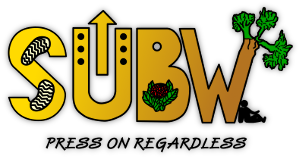by Ian “Nipper” Wilson
SUBW is 50 years old this year (1996). This article gives a brief history of the club. Much of the information for this article comes from articles published by Ian Ross and Ben Sandilands in the 40th Anniversary Magazine, Press On.
Sydney University Bushwalkers was formed in 1946, the inaugural meeting was held on 22nd October of that year. (This meeting was held in the Botany Building – nice to see that history is being maintained.) It was formed by a group of (mainly) science students who had been walking as an informal group. They became conscious that they lacked three things: good maps, good information and some form of transport – for you young’uns there was still petrol rationing after the war in 1946. As Ian Ross stated:
“there were already bushwalking clubs, and some of them still exist, but they seemed rather stuffy and regulated. There were tales going about that you actually had to follow the walks leader.”
Paddy Pallin’s shop was the main source of information and gear – that you didn’t make yourself or source from war surplus. Walks in the early days were mainly on the (so-called) Blue Mountains Tourist Map – which covered every thing from the Colo to Wingecarribee and Camden to Abercrombie. Some use was made of hand sketches from aerial photos. Walks north of Bell’s Line of Road were very rare, though Newnes was visited. Access to Yerranderie was through Camden and Wollondilly. A mail car or hitchhiking being the most likely means of transport. Pubs enroute were visited, so not much has changed. Usually army boots were worn, since volleys had not yet been invented. Food was, as could be expected often surplus army ration packs
The first Tasmanian trip was in 1947/48 and this association has continued since with SUBW being very some of the most common visitors to many of the wilder peaks and scrub areas of the South West. Canyons were being done in the late 40’s.
Most of the original members left the university, the club and in many cases Australia in 49-50 having left a sense of adventure, exploration and healthy disregard for pomposity with the club.
Details of the 50’s are sketchy but as the club still exists we can assume walks were done.
The sixties saw a significant lowering in the cost of cars and petrol and so a wider variety of trips became possible. Lighter weight gear and increasing number and length of firetrails throughout bush areas saw trips that used to be week epic become common weekend trips. Canyons became big time – possibly related to nylon ropes becoming available. Club trips to Tasmania were common enough and mountaineering trips to New Zealand were on. Reflecting the dramatic lowering of transport costs in the decade. In the early sixties Federation Peak was an epic – an expedition being required. By the mid to late 60’s it was being done in a weekend – the culture of bushwalking was changing. It had been tied down by heavy gear and poor access. Now light weight gear, vastly improved maps, fire trails and dam roads opened up previously wilderness areas to the prospect of being “loved to death”. The club moved with the times – adopting sandshoes as de riguer and continuing to do exploratory trips down canyons such as Thunder and Claustral. As now there existed a “hard core” of walkers with a larger number of occasionals. Many major club trips were done in the 60’s. As can be expected in a university club there are peaks and troughs in the numbers of members and changes in attitudes as people move through the uni and on to other things. One things that makes the mid to late 70’s a little different is the beginning of an accumulation of members that didn’t go away. These people formed the originals of the “oldies”. Some of them are still to be seen today along with their younger oldy clones.
The late 70’s and 80’s saw a time of exploration by the club. The northern Blue Mountain canyons were a prime target. This area became more navigable with the release of 1:31680 and 1:25000 scale maps. The maps and aerial photos showed many interesting features and allowed intelligent guesses to be made about canyon location. The club did much of the exploration of the canyon area north of the Bell’s Line of Road.
Tasmania and increasingly New Zealand were visited, with many “hard” and many more not so hard trips being attempted and sometimes completed. More recently the club has developed something of a split personality. There is still something of the hard core of walkers doing the hard k’s but there are also a range of other activities undertaken. In the early 80’s, skiers were to be condemned. Now all the oldies wear lycra vomit tights as they try to carve S’s in the fluffy white stuff. Three peak attempts were common in the 60’s, late 70’s and 80’s now they seem fewer but they still occur. Are picnics more common? Does it matter? No, as long the exploratory trips are done. Such trips do not need to be to areas unvisited by others but are based on things like “I wonder what is there?” while studying the map. As Ben Sandilands wrote for the 40th anniversary of the club “The club seems to be completely informal but amazingly dedicated. There was no obvious hierarchy, just a wide body of experience of how to do things effectively, whether it was a laid back day at Burning Palms or a major journey into the south-west.” My experience with the club, twenty years later, has been similar.
This quote summarises, what I think the current and future members of the club should strive for. The periods when this has occurred have been the great periods of the club.
